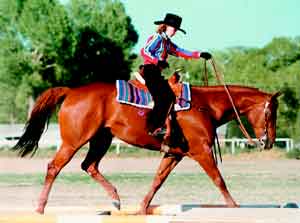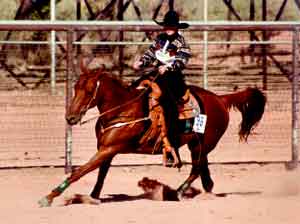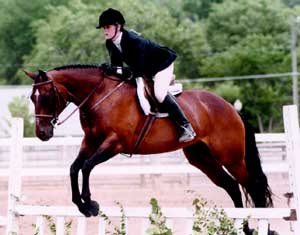 |
| Krista Wilson on “Cocky Peppers” in the Trail Class |
It’s time for the annual spring Quarter Horse
Show and Paint Horse Show at the Spanish Trail Arena. I spoke with
Susan Storey who has owned horses for 16 years and owns two show
horses here in Moab. She informed me that although horse shows are
not formally divided into local, statewide, regional and national,
they are terms that people use amongst themselves to describe the
competitiveness of the shows they’re going to; and the spring
shows in Moab are one of the biggest in the state.
Since both of Susan’s Moab horses are quarter horses, we spoke
briefly about the popularity of quarter horses. Physically, quarter
horses are sturdy horses with a small heads and muscular necks.
They have a big height range anywhere from 14.3 to 16 hands tall.
But the most outstanding feature that gives these horses their popularity
is their disposition. Overall, they have a quiet temperament and
are often recommended as “beginner” horses. Not to mention
the fact that most shows that are available are for quarter horses.
I asked Sue if it wasn’t true that paints are a breed of quarter
horse and that if a quarter horse has too much white on its coat,
it cannot be registered as a quarter horse, but has to be registered
as a paint horse. Susan informed me that Paints are a separate breed
of horse with a lot of Quarter Horse bloodlines and influence. The
topic of white markings is complex and comes with its own set of
rules. Usually, as long as a horse conforms to breed standards,
it can be bred with other breeds.
So how tall is a horse that is 15 hands high? That measurement is
taken from the ground, or the bottom of the horse’s hoof, up
to his withers. On a standard measuring tape, let’s say your
horse measures 60 inches; divide that by 4 and you have 15. Although,
there are measuring tapes available that are already divided into
“hands” so no division is necessary.
 |
| Krista Wilson on “Cocky Peppers” in the Reining Class |
Susan discussed the different events in the quarter
horse show. Though all the events have nuances that audiences may
not be aware of, some are more obvious than others. Barrel racing
and roping, or jumping, for example, most anyone can figure out
the generalities of what is expected from the horse and rider to
earn points just from watching these events. But in an event like
“Western Pleasure,” it’s not as clear unless you’ve
already been schooled in that event. Horse showing can be boring
if you don’t know enough of the technical judgement to inform
you as to what is going on. And, like any other judging, there is
a degree of subjectiveness; which is why horses are so well groomed
for these events and why riders dress as they do. If you can create
a better overall image to catch the judges’ eyes, you’ve
got a better chance.
“Western Pleasure” riding is judged strictly on the horse’s
movement, and the quality of that movement, along with their disposition.
The horses must walk, slow-jog, lope in each direction in the arena.
The back through the neck is called the “topline” and
must be level and relaxed.
“Western Horsemanship” is judged on techinical ability
of riding. Here the riders are given a pattern of cones to ride
through, and horses are not judged on quality of movement. The rider’s
position in the saddle, the hand position, how well the rider communicates
with his horse with a minimum of body gestures is all judged. The
judgement lies much more on the performance of the rider with his
horse in partnership rather than the horse himself. Susan informed
me that this is not as easy as it looks. Some horses get nervous
and know the difference between a warm up and when the judges are
present. Riders are warned not to “shool” their horses
excessively in the ring; which means, if your horse is performing
incorrectly, then correcting your horse during the event, is frowned
upon and is not considered good ring etiquette. There may be up
to 16 people moving through the ring at a time and correcting your
horse while performing may disrupt someone else’s performance.
In “Showmanship” the horse is never ridden, but is shown
at halter. There are a series of patterns, pivoting and lining up
the horse along with other maneuvers that must be performed. Judgement
is based upon how well a person performs those maneuvers, how well
the horse listens and how well the horse is shown.
 |
| Krista Wilson on “Boknows Assets” in the Hunter Hack event |
With “Hunter-hack” there are two jumps,
and judging is based on the form over the rail as well as the movement
around the rail (rail pertains to riding around the arena).
“Hunter Under Saddle” has the same rules as Western Pleasure
but is executed under English Tack.
This year there are well over 100 entrants a day for the Quarter
Horse Show; and over 80 different classes depending on age of horse,
division of rider and the event. Divisions of classes are usually
set up as follows: junior horses are age 5 years old and younger,
senior horses are age 6 years old and older. Two-year old horses
cannot be shown in riding classes until July 1st of their 2nd year,
but they can be younger in other events. In open division classes,
anyone can ride in them with any age of horse.
Some classes for Paint horses have the same regulations for judgements,
although each horse association has its own regulations.
What are the main reasons people show their horses? Well, Susan
told me, “Trainers make their living by showing and promoting
the horses they are training. A lot of horses are with a trainer
year round. So, it can be everything from making a living, to just
being out there and having a nice day with your horse.
How much training is required? Susan says that, “You’re
always working on something, because your horse is always looking
for a way to get out of it. Training depends on if you have a trained
horse already. For maintenance, it usually takes getting out and
riding or taking them through their paces 3 times a week. A young
horse that still needs a lot of training, would require getting
out with them at least 5 times a week. And, when they’ve been
with a trainer, ususally a good 1-3 months; when they come back
you have to learn that horse’s habits and quirks and work on
establishing a relationship with that horse. It’s all about
the partnership you establish between you and your horse. Pushing
doesn’t work! You want to make it a good experience for the
horse and get them to relax. I also strongly believe in ‘turning
horses out’ for free time just to run and play a bit, so they
can just be horses.”
I asked Susan if she was going to show either of her horses this
year, and her answer... “I’m going to show my 3 year old
in Western Pleasure. He’s still pretty young and I would like
to see just to see how he responds to all the people and commotion.
I just want to see how he acts in this kind of situation.”
“What kind of advice would you have for the would-be horse
owner, probably the first-timer?” I asked.
“Go to a reputable horse trainer or horse person to buy the
proper animal. Obviously, horses are big animals and can hurt you
without intending to. A lot of people want to get something cheap
for their kids to ride. This is precisely where I would spend the
extra money to buy a good, safe horse that I wouldn’t be afraid
to put my child upon. Spend the extra money to know what you’re
really getting. And, if you want a show horse, the horse show is
a good place to look for one. Horses are always for sale, and the
show is the best place to watch them in that environment, rather
than when they’re at home, where the situation is totally different,
and you wouldn’t be able to notice if they are ring sour,”
states Susan.
“And by ring sour you mean...what?” I asked.
“Ring sour is when a horse is shown so much they don’t
enjoy it anymore, they begin to cheat and “do their own thing,”
said Susan.
There are alot of young riders in the horse show, as well as older,
novice riders. One of the best things that happens between a child
and his horse is learning early on the responsibility that comes
from caring for an animal, especially a horse since they require
more than just the basic feeding and grooming. If you’re going
to be riding in a horse show, there’s the added responsibility
of training with that horse.
So, come out to the spring horse shows. It’s a great way to
spend the day or an afternoon and get more acquainted with the world
of horses.
© 2001 Moab Happenings. All rights reserved. Reproduction of information contained in this site is expressly prohibited.